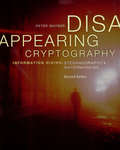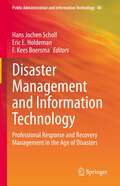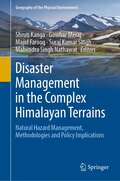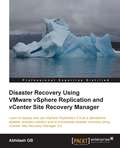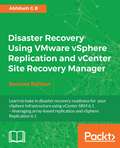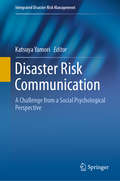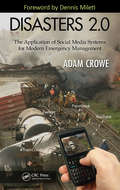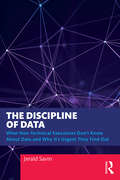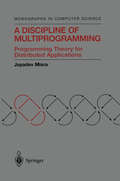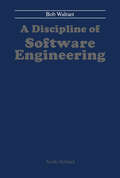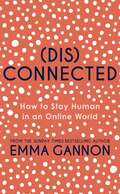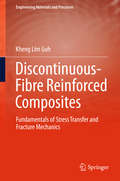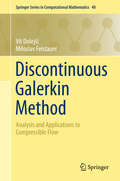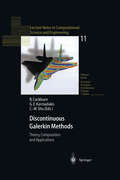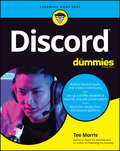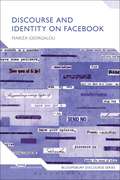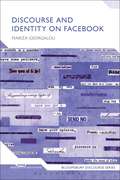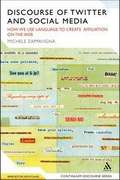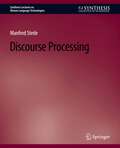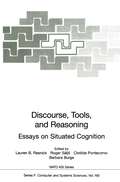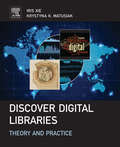- Table View
- List View
Disappearing Cryptography: Information Hiding: Steganography & Watermarking (The Morgan Kaufmann Series in Software Engineering and Programming)
by Peter WaynerDisappearing Cryptography, Second Edition describes how to take words, sounds, or images and hide them in digital data so they look like other words, sounds, or images. When used properly, this powerful technique makes it almost impossible to trace the author and the recipient of a message. Conversations can be submerged in the flow of information through the Internet so that no one can know if a conversation exists at all.This full revision of the best-selling first edition describes a number of different techniques to hide information. These include encryption, making data incomprehensible; steganography, embedding information into video, audio, or graphics files; watermarking, hiding data in the noise of image or sound files; mimicry, "dressing up" data and making it appear to be other data, and more. The second edition also includes an expanded discussion on hiding information with spread-spectrum algorithms, shuffling tricks, and synthetic worlds. Each chapter is divided into sections, first providing an introduction and high-level summary for those who want to understand the concepts without wading through technical explanations, and then presenting greater detail for those who want to write their own programs. To encourage exploration, the author's Web site www.wayner.org/books/discrypt2/ contains implementations for hiding information in lists, sentences, and images.Each chapter is divided into sections, providing first an introduction and high-level summary for those who want to understand the concepts without wading through technical details, and then an introductory set of details, for those who want to write their own programs. Fully revised and expanded. Covers key concepts for non-technical readers. Goes into technical details for those wanting to create their own programs and implement algorithms.
Disaster Management and Information Technology: Professional Response and Recovery Management in the Age of Disasters (Public Administration and Information Technology #40)
by Hans Jochen Scholl Eric E. Holdeman F. Kees BoersmaThis edited book entertains a multitude of perspectives on crisis information management systems (CIMS)-based disaster response and recovery management. The use of information technology in disaster management has become the central means for collecting, vetting, and distributing information. It also serves as the backbone for coordination and collaboration between response and recovery units as well as resource management tool. This edited volume aims at covering the whole range of application and uses of CIMS in disaster response and recovery. It showcases coordination and collaboration mechanisms between government agencies, the involvement of non-governmental entities, lessons learned as well as lessons not learned, approaches to disaster resiliency in society, community engagement in disaster/catastrophe responses and recovery, and, particularly, the role of CIMS in response and recovery. Serving as a platform for showcasing recent academic discoveries as well as a knowledge source for practitioners, this volume will be of interest to researchers and practitioners interested in disaster response, public administration, emergency management, and information systems.
Disaster Management in the Complex Himalayan Terrains: Natural Hazard Management, Methodologies and Policy Implications (Geography of the Physical Environment)
by Mahendra Singh Nathawat Shruti Kanga Suraj Kumar Singh Gowhar Meraj Majid FarooqSouth Asia, harboring the complex Himalayan terrains, has over one-fifth of the world’s population and is recognized as the most hazard-prone region of the world. The exponential increase in population with the consequent pressure on natural resources and continued high rates of poverty and food insecurity also makes this region the most vulnerable region to hazards in the world as far as the impacts of climate change are concerned. Over the last century, the climatic trends in South-Asia have been observed to be characterized by increasing air temperatures and an increasing trend in the intensity and frequency of extreme events. IPCC (2014) has reported that the Himalayan highlands shall face significant warming over the next century. The increasing frequency of natural hazards due to the impacts of climate change in the Himalayas calls for efficient management and policymaking in these regions, which can only be implemented by the local governments through an established science-based robust action plan. This edited volume focuses on the management of natural hazards using innovative techniques of spatial information sciences and satellite remote sensing. It contains chapters from eminent researchers and experts in the field of hazard management, remote sensing, and GIS. The primary focus of this book is to replenish the gap in the available literature on the subject by bringing the concepts, theories, and practical experiences of the specialists and professionals in this field together in one volume to help students, researchers, and policymakers to address issues concerning management and policy implications of natural hazards in the complex Himalayan region.
Disaster Recovery Using VMware vSphere Replication and vCenter Site Recovery Manager
by Abhilash GbThis is a step-by-step guide that will help you understand disaster recovery using VMware vSphere Replication 5.5 and VMware vCenter Site Recovery Manager (SRM) 5.5. The topics and configuration procedures are accompanied with relevant screenshots, flowcharts, and logical diagrams that makes grasping the concepts easier. This book is a guide for anyone who is keen on using vSphere Replication or vCenter Site Recovery Manager as a disaster recovery solution. This is an excellent handbook for solution architects, administrators, on-field engineers, and support professionals. Although the book assumes that the reader has some basic knowledge of data center virtualization using VMware vSphere, it can still be a very good reference for anyone who is new to virtualization.
Disaster Recovery Using VMware vSphere Replication and vCenter Site Recovery Manager - Second Edition
by Abhilash G BLearn to bake in disaster recovery readiness for your vSphere Infrastructure using vCenter SRM 6.1, leveraging array-based replication and vSphere Replication 6.1 About This Book • This is the first book on the market that provides an extensive disaster recovery solution using the latest vSphere Replication and vCenter Site Recovery Manager • Master the skills of protecting your virtual machines by replicating and recovering them in seconds • This practical, step-by-step guide will help you protect all your applications with Site Recovery Manager and Replication Who This Book Is For If you are a system administrator who is looking for a disaster recovery solution using the latest VMware vSphere Replication and vCenter Site Recovery Manager, this book is perfect for you. You should have a basic knowledge of virtual machines and data center operations. What You Will Learn • Familiarize yourself with disaster recovery concepts and the architecture of vCenter Site Recovery Manager and vSphere Replication. • Deploy and Configure vCenter Site Recovery Manager to leverage array-based replication and vSphere Replication. • Use vSphere Replication as a standalone disaster recovery solution. • Enabling protection of Virtual Machines by creating Protection Groups. • Enable orchestration of the recovery of protected virtual machines by creating Recovery Plans. • Migrate virtual machine workload from one site to another using Recovery Plans • Testing and Performing a failover or failback of Virtual Machines using Recovery Plans • Enable vRealize Orchestrator Plugins for SRM and vSphere Replication. In Detail VMware vCenter Site Recovery manage is an orchestration tool used to automate disaster recovery in a manner that no other solution does. It is programmed to leverage array-based replication and VMware's proprietary vSphere Replication engine. The book begins by talking about the architecture of SRM and guides you through the procedures involved in installing and configuring SRM to leverage array-based replication. You will then learn how to protect your virtual machines by creating Protection Groups and validate their recoverability by testing recovery plans and even performing failover and failback. Moving on, you will learn how to install and configure vSphere Replication as a standalone disaster recovery solution. It also guides you through the procedures involved in configuring SRM to leverage vSphere replication. Finally, you will learn how to deploy and configure vRealize Orchestrator and its plugin for SRM and vSphere Replication. Style and approach This is a practical, step-by-step guide on implementing a disaster recovery solution for your organization using VMware vSphere Replication and vCenter Site Recovery Manager.
Disaster Risk Communication: A Challenge from a Social Psychological Perspective (Integrated Disaster Risk Management)
by Katsuya YamoriThis book provides a unique blend of integrated disaster risk communication research conducted by authors with diverse backgrounds, including social psychology, sociology, civil engineering, informatics, and meteorology. It reports on the latest advances in collaborative and participatory action research on community-based disaster management from the frontline in Japan, Nepal, China and the USA. In addition, it employs and integrate a broad range of methodologies, including mathematical analyses, computer simulations, questionnaire surveys, gaming approaches, and participatory observation. Each chapter deals with disaster risk communication initiatives to address various hazards, such as earthquakes, tsunamis, floods and landslides, which are uniquely integrated from a social psychological perspective.
Disasters 2.0: The Application of Social Media Systems for Modern Emergency Management
by Adam CroweEmerging social media and so-called Web 2.0 technologies will continue to have a great impact on the practice and application of the emergency management function in every public safety sector. Disasters 2.0: The Application of Social Media Systems for Modern Emergency Management prepares emergency managers and first responders to successfully appl
Disasters 2.0: The Application of Social Media Systems for Modern Emergency Management
by Adam CroweEmerging social media and so-called Web 2.0 technologies will continue to have a great impact on the practice and application of the emergency management function in every public safety sector. Disasters 2.0: The Application of Social Media Systems for Modern Emergency Management prepares emergency managers and first responders to successfully appl
The Discipline of Data: What Non-Technical Executives Don't Know About Data and Why It's Urgent They Find Out
by Jerald SavinPulling aside the curtain of ‘Big Data’ buzz, this book introduces C-suite and other non-technical senior leaders to the essentials of obtaining and maintaining accurate, reliable data, especially for decision-making purposes. Bad data begets bad decisions, and an understanding of data fundamentals — how data is generated, organized, stored, evaluated, and maintained — has never been more important when solving problems such as the pandemic-related supply chain crisis. This book addresses the data-related challenges that businesses face, answering questions such as: What are the characteristics of high-quality data? How do you get from bad data to good data? What procedures and practices ensure high-quality data? How do you know whether your data supports the decisions you need to make? This clear and valuable resource will appeal to C-suite executives and top-line managers across industries, as well as business analysts at all career stages and data analytics students.
The Discipline of Data: What Non-Technical Executives Don't Know About Data and Why It's Urgent They Find Out
by Jerald SavinPulling aside the curtain of ‘Big Data’ buzz, this book introduces C-suite and other non-technical senior leaders to the essentials of obtaining and maintaining accurate, reliable data, especially for decision-making purposes. Bad data begets bad decisions, and an understanding of data fundamentals — how data is generated, organized, stored, evaluated, and maintained — has never been more important when solving problems such as the pandemic-related supply chain crisis. This book addresses the data-related challenges that businesses face, answering questions such as: What are the characteristics of high-quality data? How do you get from bad data to good data? What procedures and practices ensure high-quality data? How do you know whether your data supports the decisions you need to make? This clear and valuable resource will appeal to C-suite executives and top-line managers across industries, as well as business analysts at all career stages and data analytics students.
A Discipline of Multiprogramming: Programming Theory for Distributed Applications (Monographs in Computer Science)
by Jayadev MisraIn this book, a programming model is developed that addresses the fundamental issues of 'large-scale programming'. The approach unifies several concepts from database theory, object-oriented programming and designs of reactive systems. The model and the associated theory has been christened "Seuss." The major goal of Seuss is to simplify multiprogramming. To this end, the concern of concurrent implementation is separated from the core program design problem. A program execution is understood as a single thread of control - sequential executions of actions that are chosen according to some scheduling policy. As a consequence, it is possible to reason about the properties of a program from its single execution thread.
A Discipline of Software Engineering
by B. WalraetThis comprehensive approach to the creation of software systems charts a road through system modelling techniques, allowing software engineers to create software meeting two very basic requirements: • that the software system represent a narrow emulation of the organization system that served as its model; • and that the software system display life attributes identical to those of the organization system that it automatizes.The result is a quantum leap increase in software application quality. Such benefit is achieved by the introduction of a fundamental paradigm: the office-floor metaphor which incorporates such well-balanced basic ideas as the functional normalization of tasks and information (in sharp contrast to the classic data normalization) and the principle of tenant-ownership.
Disconnected: How to Stay Human in an Online World
by Emma GannonPRE-ORDER NOW: The new book by Sunday Times bestselling author, Emma Gannon I love Emma Gannon's wise and refreshing perspective on work, and more broadly on the challenges of building a meaningful life in an era of distraction, overwhelm and uncertainty. - Oliver Burkeman, New York Times Bestselling author of Four Thousand Weeks__________Millennials might have grown up online but now they want to log off. And it's not just millennials. A year of lockdowns, Zoom meetings and reduced physical contact has made us more dependent on the internet than ever before - but has it lost its humanity? Our focus on community and real connection has been sent off-course and we're becoming more aware of how the algorithm manipulates us and how our data has made us a product to be sold. So, where do we go from here and how can we get back on track? (Dis)connected examines these topics and offers tangible tips and advice for those of us who might feel a little lost right now and want to find themselves again.__________Emma Gannon is a cordial and provocative spirit. Read her, listen to her, explore her world and the world at large through her eyes. Hers is a journey well worth taking. - Julia Cameron, New York Times Bestselling author of The Artist's Way
Discontinuous-Fibre Reinforced Composites: Fundamentals of Stress Transfer and Fracture Mechanics (Engineering Materials and Processes)
by Kheng Lim GohThis book provides a simple and unified approach to the mechanics of discontinuous-fibre reinforced composites, and introduces readers as generally as possible to the key concepts regarding the mechanics of elastic stress transfer, intermediate modes of stress transfer, plastic stress transfer, fibre pull-out, fibre fragmentation and matrix rupture. These concepts are subsequently applied to progressive stages of the loading process, through to the composite fractures. The book offers a valuable guide for advanced undergraduate and graduate students attending lecture courses on fibre composites. It is also intended for beginning researchers who wish to develop deeper insights into how discontinuous fibre provides reinforcement to composites, and for engineers, particularly those who wish to apply the concepts presented here to design and develop discontinuous-fibre reinforced composites.
Discontinuous Galerkin Method: Analysis and Applications to Compressible Flow (Springer Series in Computational Mathematics #48)
by Vít Dolejší Miloslav FeistauerThe subject of the book is the mathematical theory of the discontinuous Galerkin method (DGM), which is a relatively new technique for the numerical solution of partial differential equations. The book is concerned with the DGM developed for elliptic and parabolic equations and its applications to the numerical simulation of compressible flow. It deals with the theoretical as well as practical aspects of the DGM and treats the basic concepts and ideas of the DGM, as well as the latest significant findings and achievements in this area. The main benefit for readers and the book’s uniqueness lie in the fact that it is sufficiently detailed, extensive and mathematically precise, while at the same time providing a comprehensible guide through a wide spectrum of discontinuous Galerkin techniques and a survey of the latest efficient, accurate and robust discontinuous Galerkin schemes for the solution of compressible flow.
Discontinuous Galerkin Methods: Theory, Computation and Applications (Lecture Notes in Computational Science and Engineering #11)
by Bernardo Cockburn George E. Karniadakis Chi-Wang ShuA class of finite element methods, the Discontinuous Galerkin Methods (DGM), has been under rapid development recently and has found its use very quickly in such diverse applications as aeroacoustics, semi-conductor device simula tion, turbomachinery, turbulent flows, materials processing, MHD and plasma simulations, and image processing. While there has been a lot of interest from mathematicians, physicists and engineers in DGM, only scattered information is available and there has been no prior effort in organizing and publishing the existing volume of knowledge on this subject. In May 24-26, 1999 we organized in Newport (Rhode Island, USA), the first international symposium on DGM with equal emphasis on the theory, numerical implementation, and applications. Eighteen invited speakers, lead ers in the field, and thirty-two contributors presented various aspects and addressed open issues on DGM. In this volume we include forty-nine papers presented in the Symposium as well as a survey paper written by the organiz ers. All papers were peer-reviewed. A summary of these papers is included in the survey paper, which also provides a historical perspective of the evolution of DGM and its relation to other numerical methods. We hope this volume will become a major reference in this topic. It is intended for students and researchers who work in theory and application of numerical solution of convection dominated partial differential equations. The papers were written with the assumption that the reader has some knowledge of classical finite elements and finite volume methods.
Discord For Dummies
by Tee MorrisBuild a Discord studio and create a community Set up a profile, establish a channel, and join conversations Maximize results from the Discord platform Harmonize with your audience on Discord This evolving digital age offers numerous options for instant communications. Discord has emerged as a major player in connecting people from all parts of the world via text, audio, and video. Originally favored by the online gaming community, Discord now attracts content creators of all backgrounds eager to cultivate communities around all types of topics. Written by an expert in personal broadcasting for business or pleasure, the book is ideal for anyone looking to connect with a larger audience. Inside... Set up your profile Establish a server Join conversations Play by the rules Build a studio Create a community Apply Discord to your daily routine
Discord For Dummies
by Tee MorrisBuild a Discord studio and create a community Set up a profile, establish a channel, and join conversations Maximize results from the Discord platform Harmonize with your audience on Discord This evolving digital age offers numerous options for instant communications. Discord has emerged as a major player in connecting people from all parts of the world via text, audio, and video. Originally favored by the online gaming community, Discord now attracts content creators of all backgrounds eager to cultivate communities around all types of topics. Written by an expert in personal broadcasting for business or pleasure, the book is ideal for anyone looking to connect with a larger audience. Inside... Set up your profile Establish a server Join conversations Play by the rules Build a studio Create a community Apply Discord to your daily routine
Discourse and Identity on Facebook (Bloomsbury Discourse)
by Mariza GeorgalouSocial network sites are dynamic online socio-cultural arenas which give users ample and unprecedented opportunities for self-presentation through the meshing of language with other semiotic modes. With a focus on Facebook, one of the most widely-used online social network sites, this book brings together ideas and concepts related to language online, multimodality, and identity through five topical issues. These include place, time, profession and education, stance-taking, and privacy. The book features a discourse-centred online ethnography that provides authentic verbal and multimodal Facebook posts in both Greek and English . These are complemented with insights from interviews with Facebook participants. The examples bring to life various engaging instances of self- and other-presentation on Facebook identifying the ways in which users can:- locate themselves in terms of place and time;- announce activities, share and broaden their expertise and buttress solidarity among colleagues and fellow students;- communicate emotions, tastes, thoughts, opinions and assessments; - control the flow of textual information on their Facebook profiles to secure their privacy. Focusing on discourse manifestations of identity, this book also shows how Facebook can function as a space for vernacular literacy practices, a silo of relationships, a digital memory bank, a research tool, a knowledge forum, a cardiograph of a society, and a grassroots channel.
Discourse and Identity on Facebook: How We Use Language And Multimodal Texts To Present Identity Online (Bloomsbury Discourse)
by Mariza GeorgalouSocial network sites are dynamic online socio-cultural arenas which give users ample and unprecedented opportunities for self-presentation through the meshing of language with other semiotic modes. With a focus on Facebook, one of the most widely-used online social network sites, this book brings together ideas and concepts related to language online, multimodality, and identity through five topical issues. These include place, time, profession and education, stance-taking, and privacy. The book features a discourse-centred online ethnography that provides authentic verbal and multimodal Facebook posts in both Greek and English . These are complemented with insights from interviews with Facebook participants. The examples bring to life various engaging instances of self- and other-presentation on Facebook identifying the ways in which users can:- locate themselves in terms of place and time;- announce activities, share and broaden their expertise and buttress solidarity among colleagues and fellow students;- communicate emotions, tastes, thoughts, opinions and assessments; - control the flow of textual information on their Facebook profiles to secure their privacy. Focusing on discourse manifestations of identity, this book also shows how Facebook can function as a space for vernacular literacy practices, a silo of relationships, a digital memory bank, a research tool, a knowledge forum, a cardiograph of a society, and a grassroots channel.
Discourse, Interaction and Communication: Proceedings of the Fourth International Colloquium on Cognitive Science (ICCS-95) (Philosophical Studies Series #72)
by X. Arrazola K. Korta Francis Jeffrey PelletierDISCOURSE, INTERACTION, AND COMMUNICATION Co-organized by the Department of Logic and Philosophy of Science and the Institute for Logic, Cognition, Language, and Infonnation (ILCLI) both from the University of the Basque Country, tlle Fourth International Colloquium on Cognitive Science (ICCS-95) gathered at Donostia - San Sebastian ti'om May 3 to 6, 1995, with the following as its main topics: 1. Social Action and Cooperation. 2. Cognitive Approaches in Discourse Processing: Grammatical and Semantical Aspects. 3. Models of Infonnation in Communication Systems. 4. Cognitive Simulation: Scope and Limits. More tllan one hundred researchers from all over the world exchanged their most recent contributions to Cognitive Science in an exceptionally fruitful annosphere. In this volume we include a small though representative sample of tlle main papers. They all were invited papers except the one by Peter Juel Henrichsen, a contributed paper tllat merited tlle IBERDROLA - Gipuzkoako Foru Aldundia: Best Paper Award, set up in ICCS-95 for the first time.
Discourse Of Twitter And Social Media: How We Use Language To Create Affiliation On The Web (PDF)
by Michele ZappavignaSocial media such as microblogging services and social networking sites are changing the way people interact online and search for information and opinions. This book investigates linguistic patterns in electronic discourse, looking at online evaluative language, Internet slang, memes and ambient affiliation using a large Twitter corpus (over 100 million tweets) alongside specialized case studies. The author argues that we are currently witnessing a cultural movement from online conversation to what can be termed 'searchable talk' - online talk where people affiliate by making their discourse findable (for example, via metadata such as Twitter hashtags) by others holding similar interests. This cutting edge text will be of interest to all scholars and students dealing with electronically mediated discourse.
Discourse Processing (Synthesis Lectures on Human Language Technologies)
by Manfred StedeDiscourse Processing here is framed as marking up a text with structural descriptions on several levels, which can serve to support many language-processing or text-mining tasks. We first explore some ways of assigning structure on the document level: the logical document structure as determined by the layout of the text, its genre-specific content structure, and its breakdown into topical segments. Then the focus moves to phenomena of local coherence. We introduce the problem of coreference and look at methods for building chains of coreferring entities in the text. Next, the notion of coherence relation is introduced as the second important factor of local coherence. We study the role of connectives and other means of signaling such relations in text, and then return to the level of larger textual units, where tree or graph structures can be ascribed by recursively assigning coherence relations. Taken together, these descriptions can inform text summarization, information extraction, discourse-aware sentiment analysis, question answering, and the like. Table of Contents: Introduction / Large Discourse Units and Topics / Coreference Resolution / Small Discourse Units and Coherence Relations / Summary: Text Structure on Multiple Interacting Levels
Discourse, Tools and Reasoning: Essays on Situated Cognition (NATO ASI Subseries F: #160)
by Lauren B. Resnick Roger Säljö Clotilde Pontecorvo Barbara BurgeNot long ago, projections of how office technologies would revolutionize the production of documents in a high-tech future carriedmany promises. The paper less office and the seamless and problem-free sharing of texts and other work materials among co-workers werejust around the corner, we were told. To anyone who has been involved in putting together a volume of the present kind, such forecasts will be met with considerable skepticism, if not outright distrust. The diskette, the email, the fax, the net, and all the other forms of communication that are now around are powerful assets, but they do not in any way reduce the flow of paper or the complexity of coordinating activities involved in producing an artifact such as a book. Instead, the reverse seems to be true. Obviously, the use of such tools requires considerable skill at the center of coordination, to borrow an expression from a chapter in this volume. As editors, we have been fortunate to have Ms. Lotta Strand, Linkoping University, at the center of the distributed activity that producing this volume has required over the last few years. With her considerable skill and patience, Ms. Strand and her work provide a powerful illustration of the main thrust of most of the chapters in this volume: Practice is a coordination of thinking and action, and many things had to be kept in mind during the production of this volume.
Discover Digital Libraries: Theory and Practice
by Iris Xie Krystyna MatusiakDiscover Digital Libraries: Theory and Practice is a book that integrates both research and practice concerning digital library development, use, preservation, and evaluation. The combination of current research and practical guidelines is a unique strength of this book. The authors bring in-depth expertise on different digital library issues and synthesize theoretical and practical perspectives relevant to researchers, practitioners, and students. The book presents a comprehensive overview of the different approaches and tools for digital library development, including discussions of the social and legal issues associated with digital libraries. Readers will find current research and the best practices of digital libraries, providing both US and international perspectives on the development of digital libraries and their components, including collection, digitization, metadata, interface design, sustainability, preservation, retrieval, and evaluation of digital libraries.Offers an overview of digital libraries and the conceptual and practical understanding of digital librariesPresents the lifecycle of digital library design, use, preservation and evaluation, including collection development, digitization of static and multimedia resources, metadata, digital library development and interface design, digital information searching, digital preservation, and digital library evaluationSynthesizes current research and the best practices of digital libraries, providing both US and international perspectives on the development of digital librariesIntroduces new developments in the area of digital libraries, such as large-scale digital libraries, social media applications in digital libraries, multilingual digital libraries, digital curation, linked data, rapid capture, guidelines for the digitization of multimedia resourcesHighlights the impact, challenges, suggestions for overcoming these challenges, and trends of present and future development of digital libraries Offers a comprehensive bibliography for each chapter
